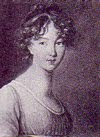
Today is Jane Austen’s birthday. This year is the 200th anniversary of her first published novel, Sense and Sensibility. I have been reading Jane Austen’s novels since the age of eleven, and then her other works, letters, biographies and critical works (books, essays, etc.) in English about her and her output for most of my adult personal and professional life. I have also made her or her work the subject of some of my needlework.
As I currently do not have a stand-alone embroidered piece quoting or depicting some aspect of Sense and Sensibility as I do of some of the other novels, I thought I would commemorate the beginning of the anniversaries of the publication of Austen's works with a small quilt that I made in 1996. The quilt is entirely hand pieced, hand quilted and hand embroidered. It is made of 100% cotton fabrics (including the wadding/batting), 28 count linen, quilted and pieced with cotton threads, and embroidered with DMC 25 Mouline Special cotton embroidery floss dark green (500) and pale blue (519) after the colour of Austen’s clothing in a painting of her by her sister, Cassandra. The Pineapple blocks were foundation pieced and are just under 4” square each, and the entire quilt measures 17 ½” x 12”. I chose the Pineapple block pattern not only because it is the perfect way to use various fabrics in one block but because it is multi-layered, as are Austen’s works. The pineapple is also a symbol of welcome and hospitality, and a widely used artistic medium that would have been familiar to Austen. The edges are not “pictures of perfection”* but I am not fussed by that.

I like to “write in thread,” stitching freehand, without any pattern on the linen, and have done many pieces over the years with extensive embroidered script since I enjoy playing with thread as much as I do with dip pens and ink and paper. I also usually stitch in this shade of thread to symbolically keep the memory of the words green and fresh. This little quilt lists the titles all of the written words by Austen, except one**, currently in the public domain – there is always hope of a newly discovered letter, story sketch, etc. The squares name her novels and, in the border, the titles of the scholarly-designated Minor Works – unfinished, Juvenilia, Prayers, Letters, Detached Pieces Verses, Scraps and A Fragment. The fabrics in the Pineapple layers of each square, as mentioned above, reflect aspects of the novel, and so, Sense and Sensibility, with its serious beginning has dark fabrics at the edge with lighter coloured fabrics moving towards the centre of the block with red (financial security) at the inner edge, near the heart of the block. All of Austen’s novels have prominent serious themes but some, like Pride and Prejudice and Emma, have more of the “light, bright and sparkling,”*** about them than the others. All have women in them and clothes are always discussed so I used fabrics that were like but not necessarily reproductions of those of the 1790s-1816. I was also hampered by the small scale of the blocks and so had to use tiny prints that are suggestive rather than completely accurate. The outer edges of the Pineapple blocks are in a cream fabric which has a white Copperplate script printed on it.

The outer green border has a print of gold leaves, flowers and birds. I chose this fabric as my favourite colour is green and that, and the motifs, are symbolic of Austen’s beloved countrysides. The gold is for her words – timeless, entertaining, enlightening, comforting and luminous.
*Letter to Fanny Knight, 23-23 March, 1811
**Play of Sir Charles Grandison
*** Letter to Cassandra Austen, Thursday, 4 February, 1813
P.S. Apologies for the shredded thread in the Sense and Sensibility block - it should have been snipped before the photo was taken.




